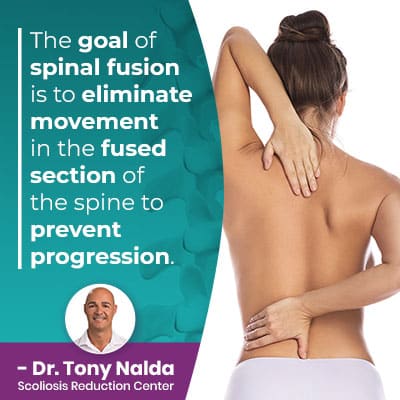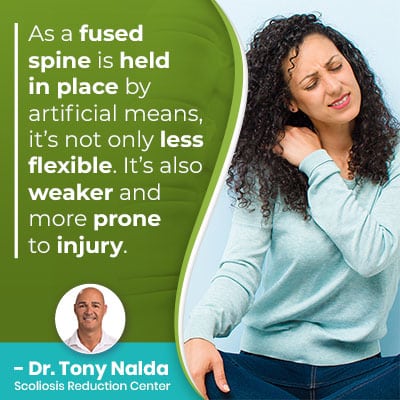What Are Scoliosis Surgery Side Effects? [Short & Long-Term]

All surgical procedures come with their share of risks, and scoliosis surgery is no exception. Spinal fusion is a lengthy, costly, and invasive surgery that’s associated with a number of potential side effects, both short and long-term.
Scoliosis surgery involves fusing the scoliotic curve’s most-tilted vertebrae together into one solid bone to stop the progression. Scoliosis surgery side effects can include infection, excessive blood loss, adverse reaction to hardware, nerve damage, loss of spinal flexibility, and range of motion.
As a progressive condition, how a diagnosis of scoliosis is responded to, in terms of treatment, can have far-reaching effects.
Table of Contents
Understanding Scoliosis
Being diagnosed with scoliosis means an unnatural sideways spinal curve, with rotation, has developed. This introduces a lot of uneven forces to the body, and as the brain and spine work together to form the central nervous system (CNS), spinal conditions can cause widespread effects.
In addition, scoliosis is progressive, meaning it has it in its nature to worsen over time, especially if left untreated or not treated proactively.
Scoliosis ranges widely in severity from mild to moderate and severe to very severe, and condition severity is determined by a measurement taken during X-ray known as Cobb angle:
- Mild scoliosis: Cobb angle measurement of between 10 and 25 degrees
- Moderate scoliosis: Cobb angle measurement of between 25 and 40 degrees
- Severe scoliosis: Cobb angle measurement of 40+ degrees
- Very-severe scoliosis: Cobb angle measurement of 80+ degrees
Condition severity is an important factor because it tells me how far out of alignment a patient’s spine is. If a patient undergoing traditional treatment progresses to the severe level, they are crossing the surgical level threshold.
There are two main scoliosis treatment approaches for patients to choose between conservative and traditional.
A conservative treatment approach is non-surgical, while the traditional approach to scoliosis treatment commonly funnels patients towards spinal fusion surgery; hence the earlier assertion that how a diagnosis is responded to can have far-reaching effects.
What is Scoliosis Surgery?
 Scoliosis surgery is also known as spinal fusion and involves fusing the most-tilted vertebrae of the unnatural curve together into one solid bone.
Scoliosis surgery is also known as spinal fusion and involves fusing the most-tilted vertebrae of the unnatural curve together into one solid bone.
While there are different types of spinal fusion, the procedure commonly involves holding the spine in place by attaching a rod with screws to each side of the spine.
The goal of spinal fusion is to eliminate movement in the fused section of the spine to prevent progression.
Because the goal of spinal fusion is to stop progression, it doesn’t actually correct scoliosis but is instead holding it in a corrective position through artificial means.
While scoliosis surgery can help make a crooked spine straight, the way it’s achieved can cause some serious potential side effects, both related to the procedure itself and how the procedure affects overall spinal health and function in the future.
Potential Short-Term Effects of Scoliosis Surgery
Scoliosis is a highly variable condition, making it complex to treat; not only does it range widely in severity, but there are also different condition types, curvature locations, and patterns, and it can affect all ages.
Because of so many variables, every patient will respond to scoliosis surgery in their own way.
There are a number of factors that can affect how a patient’s spine and body will respond to the surgery: patient age and overall health, condition type, severity, curvature type and location, and the number of vertebrae fused.
As mentioned, scoliosis surgery is lengthy and invasive, and in addition to affecting how the spine functions long term, there are also short-term risks and side effects related to the procedure itself:
- Excessive blood loss
- Infection
- Nerve damage
- Pain at the fusion site
In addition to the potential immediate effects of the procedure itself, there is also the recovery period to consider, which can also range widely from patient to patient.
During recovery, certain activities and types of movement would be restricted while healing continues.
Each case is unique, but in general, the recovery period can range from 3 to 6 months, and recovery time spent in the hospital immediately following the surgery can range from days to weeks.
Recovery time spent in the hospital involves being closely monitored for signs of infection, pain management, and learning how to move appropriately without straining the fusion site.
Excessive blood loss is a risk of the surgery, and when this happens, the chances that there will be excessive bleeding post-surgery increase, sometimes requiring a blood transfusion, and other times, excessive bleeding can be controlled with medications.
A big risk of any surgery is infection, and while less common, a delayed infection can appear years after the procedure, as well as immediately after; infection will slow recovery and affect the body’s ability to heal itself.
The fusion site can be painful, and while many cases of fusion-site pain improve throughout the recovery period, others find that the pain is permanent; factors like fusion location and the number of vertebrae fused greatly impact whether or not the fusion site is painful.
Any spinal surgery comes with the risk of nerve damage because the spine houses important nerves within.
Nerve damage that occurs during the procedure can be painful and, depending on severity, can be temporary or permanent.
So now that we’ve touched on some of the most significant risks associated with the procedure itself, let’s move on to addressing some of the surgery’s potential long-term side effects.
Potential Long-Term Effects of Scoliosis Surgery
As a non-surgical scoliosis treatment provider, it’s the long-term effects of spinal fusion that concern me the most.
The most prevalent type of scoliosis is adolescent idiopathic scoliosis (AIS), diagnosed between the ages of 10 and 18.
For adolescents on the path of traditional scoliosis treatment facing a surgical recommendation, it’s important to understand that as young patients still have growth to go through after surgery, the procedure can’t offer any guarantees that it will be successful at preventing further progression.
It’s also important for patients, and their families, to understand that there is a significant gap in the research and data on the long-term effects of spinal fusion 10, 20, and 30+ years down the road.
The reality is that we quite simply don’t know how living with a fused spine will look far into the future.
For example, the hardware used has its own lifespan, and if performed on young patients with many years of life ahead of them, one has to wonder how long the hardware will perform optimally within the body.
The younger the patient, the longer the hardware used in the fusion has to last, and the more likely it is that its natural expiration point will be reached.
When I say hardware failure, I’m referring to screws coming loose and puncturing the spine, rods becoming weaker over time and breaking, or patients having adverse reactions to the metals used.
The only recourse to hardware-related complications that can emerge over time is more surgery, and the risks of surgery only increase with age.
Two issues I’d really like to focus on under the long-term effects of scoliosis surgery umbrella are pain and flexibility because they greatly impact the quality of life.
Pain and Spinal Flexibility
Post-surgical pain and a loss in spinal flexibility are among the most commonly reported long-term effects of spinal fusion.
Many patients I see complain that their scoliosis-related pain increases after the procedure, and this is partially due to the fusion site being immovable, which also affects the vertebrae on either side of the fusion site.
In addition, the fused vertebrae and lack of movement affect the surrounding muscles that support the spine; they become strained and tight.
 As a fused spine is held in place by artificial means, it’s not only less flexible, it’s also weaker and more prone to injury.
As a fused spine is held in place by artificial means, it’s not only less flexible, it’s also weaker and more prone to injury.
The very design of the spine is based on movement, so fusing a section immovably is contrary to its movement-based design, which is why it can impair spinal function and biomechanics.
When there is a significant loss in spinal flexibility, it can affect the spine’s range of motion, making it difficult for some patients to participate in the sports/activities they once loved and now end up affecting their quality of life.
A fused spine is also at an increased risk of injury, and the psychological effect of that knowledge can be difficult for patients, leading to fear of trying new things: impacting a patient’s ability to live their best life.
To summarize, potential long-term side effects of scoliosis surgery can include:
- Nerve damage
- Increased back pain
- Loss of spinal flexibility and range of motion
- Hardware malfunction over time
- Adverse reaction to the hardware used
- Loss of spinal strength
- A spine that’s more vulnerable to injury
- Strained and sore muscles surrounding the fused section
- Emotional stress of living with a fused spine
For those who choose to forego a surgical recommendation or want to try a more natural and less-invasive option first, conservative treatment offers a non-surgical alternative with proven results.
Conclusion
I do want to be clear that not every patient who chooses spinal fusion is going to develop the aforementioned short- and long-term effects, but as the risk is there, they should be considered.
In addition, as progression can still occur after scoliosis surgery, and the loss in spinal flexibility and range of motion can be significant, a person’s overall quality of life should also be a factor.
Considering the risks, I want patients, and their families, to be fully aware so they can make an informed decision on whether to choose scoliosis surgery or a conservative non-surgical treatment option.
Here at the Scoliosis Reduction Center, I offer patients a proactive approach to scoliosis treatment that works towards preventing progression and the need for invasive surgical treatment.
Dr. Tony Nalda
DOCTOR OF CHIROPRACTIC
After receiving an undergraduate degree in psychology and his Doctorate of Chiropractic from Life University, Dr. Nalda settled in Celebration, Florida and proceeded to build one of Central Florida’s most successful chiropractic clinics.
His experience with patients suffering from scoliosis, and the confusion and frustration they faced, led him to seek a specialty in scoliosis care. In 2006 he completed his Intensive Care Certification from CLEAR Institute, a leading scoliosis educational and certification center.
About Dr. Tony Nalda
 Ready to explore scoliosis treatment? Contact Us Now
Ready to explore scoliosis treatment? Contact Us Now





